Andy Extance discovers how portable infrared absorption and Raman scattering analysis tools are inspiring new uses – from the battlefield to people’s homes
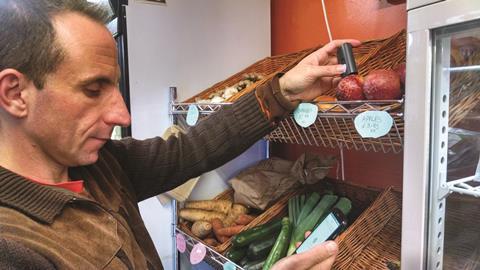
As a team examines a stash of tablets hidden in a forest, it’s not just sunlight filtering through the leaves that illuminates their investigation. They’re equipped with handheld infrared and Raman spectrometers, with which they quickly establish what drugs they’re dealing with. Then, cut to Iraq, where a similarly armed explosives disposal expert investigates a suspicious package.
These are the scenes I imagine as I stand in my local shops with a matchbox-sized SCiO near-infrared (NIR) spectrometer, zapping fruit and meat (see Spectroscopy at home box). While what I’m doing seems mundane by comparison, the transition from the £25,000-plus high-specification systems I’m envisioning to the $300 (£230) SCiO consumer device I’m holding in my hand is remarkable. The developers of such devices have moved chemical analysis beyond labs, letting us potentially become the stars of our own forensic fantasies.
While infrared and Raman handheld spectrometers all shine similar colours of invisible light at their targets, they are not all the same – and neither are users. For a forensic scientist, a drug quality regulator, a farmer, a soldier, or simply someone who’s very particular about their food, requirements will differ greatly. These new tools are firing up users’ imaginations in many fields, and continuously spawning new applications.
Some of the first users equipped with portable spectrometers weren’t even human – they were remote robotic space probes hunting for signs of extraterrestrial life. Other pioneers were military, hunting explosives and biological weapons, according to Roy Goodacre from the University of Manchester, UK. These demands coincided with a shrinkage of optics technology thanks to smartphones that would have been ‘very challenging indeed only a couple of decades ago’, Goodacre adds. Building on this convergence, as of 2015 there were at least 38 different handheld infrared and Raman spectrometers in the £25,000–£45,000 price range for his team to survey.1
The portable FirstGuard Raman spectrometer in the lab of Sulaf Assi at Bournemouth University, UK, is already six years old, showing how well-established the market is. Nearby is a container packed with diamond-shaped blue pills, because handheld spectroscopy has inspired Assi to investigate prescription drugs, and unmask their counterfeit imposters. These samples claim to be the sex aid drug Viagra, coming from sources including a Turkish street market.
Spectroscopy at home
Wandering around my local stores, holding a gadget to their products evokes a strange feeling. It’s not paranoia, exactly – I wanted the staff to come and ask what I was doing. Having pressed the glowing button on the gadget and read off its conclusions from my phone, I felt the SCiO could help them to monitor whether their stock was as good as usual.
While I was impressed by the fact the SCiO could test foodstuffs through clear plastic packages, testing loose fruit was the most satisfying pre-set software function for me. The SCiO I’d been loaned told me that the apples delivered to my house by a fruit and vegetable box scheme were sweeter than those from nearby shops. While I felt pleased about having shopped well, would checking this become a regular habit if I owned one though? I’m not sure.
I think that the SCiO spectrometer has most promise for hobby scientists. I most enjoyed trying to use it to demonstrate infrared absorption by carbon dioxide – the principle underlying the greenhouse effect. I mixed vinegar and sodium bicarbonate to generate carbon dioxide in a small plastic bottle, and measured the result. Seeing no change from the spectrum of the empty bottle, I then looked up carbon dioxide’s absorption bands, and found they fall outside the SCiO’s 700–1100nm wavelength window, leaving me (infra)red-faced!
Handy data
Comparing similar-looking pills, Assi uses the drill-shaped FirstGuard, made by Rigaku and a new Bravo from Bruker. Both are Raman spectrometers, but with complementary capabilities, with the FirstGuard covering the 200–2000cm–1 wavenumber range, and the Bravo Duo spanning 300–3200cm–1. Using two instruments with different wavelength ranges provides more data points, which makes it easier to differentiate between real and counterfeit drugs.

Noting the benefit that handheld instruments don’t require grinding up and destroying pills, she finds both pills contain sildenafil citrate, Viagra’s active ingredient. ‘Sometimes you get more in counterfeits than in authentics,’ Assi adds – but that’s a problem because it raises the risk of heart attacks. The instruments shine their lasers at the pills, with their detectors measuring the light that scatters back. And for one of the pills, the resulting Raman spectra have a much stronger signal for titanium dioxide, used in the pill’s coating.
The instruments themselves can all compare spectra with reference libraries to identify simple substances, but this isn’t always enough if a counterfeit pill contains the right drug. Assi has therefore previously done her own mathematical analyses, finding that two regions of the spectra are critical. When she plots the signal strength from absorption relating to sildenafil citrate on one axis, and titanium dioxide on the other, authentic samples cluster together, with counterfeits scattered around. From that, she concludes the pill with the stronger titanium dioxide signal is the real one.
Sometimes you get more active ingredients in counterfeit drugs than in the authentic versions
Assi likens the physical processes involved in Raman spectroscopy to fights between bonds in the molecules in the sample and the photons of light hitting it. In most cases, no-one wins the fight, and the photon comes back unaltered, which is known as Rayleigh scattering. But once in hundreds of millions of fights, one of them does win, and takes energy from their opponent, which changes the colour of the returning photon. The sensor detects that colour change – known as Stokes or anti-Stokes scattering, depending on the direction of energy transfer.
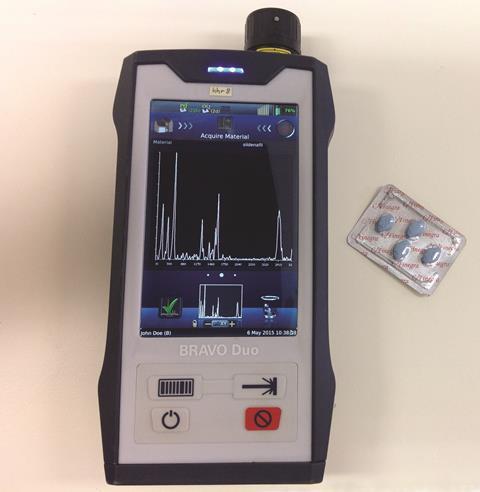
The rarity of energy exchange ensures spectra with sharp, narrow absorbance signals originating from carbon–carbon or carbon–oxygen bonds. This is ideal if users want to identify specific molecules. But Raman scattering’s rarity also means that concentrations under 5–10% by mass can be hard to see. Below that level it’s possible to use surface-enhanced Raman spectroscopy, where plasmonic behaviour at metal surfaces focusses light and strengthens signals. But in drug testing that typically involves mixing a tablet with metal compounds to make a silver or gold colloid, which destroys the tablets, Assi explains.
Absorbing information
Assi also uses NIR spectroscopy to examine tablets. In NIR spectroscopy, light is absorbed while exciting molecular vibrations and rotations, giving much stronger signals than Raman. She uses it to look at physical properties such as tablet shape, colour and water content. ‘We see broad peaks, mostly hydrogen bonding and covalent bonds between hydrogen atoms and carbon and nitrogen,’ she says.
Facing food frustrations when he moved from an Israeli farm to the US, Dror Sharon likewise opted for NIR. He found it hard to get food that consistently matched that grown at home, and therefore searched the internet for a gadget that could assess food quality. ‘I couldn’t find anything, so I decided to go ahead and make one,’ says Sharon, who is now chief executive officer of Tel Aviv-headquartered Consumer Physics. ‘As chance had it my cofounder, Damian Goldring, was looking at different optical technologies and we were able to start a company.’
What emerged was the SCiO ‘molecular sensor’, which exploits both cloud computing power and ‘cutting edge manufacturing technologies from micro-optics’, explains Sharon. The tiny device connects to a smartphone by Bluetooth, and uses its internet connection to compare what it senses with a large and growing reference library. That comparison involves ‘analysis algorithms that previously you wouldn’t be able to do unless you were a highly trained technician with a very large machine’, he says.
We are complementing analytical chemists
The SCiO therefore exceeds normal expectations for food analysis in detecting components that are present in concentrations down to 0.5% by mass, Sharon asserts. However, it can’t tell users about things like pesticides residues that may be present at parts per million (ppm) levels. The consumer device mainly provides simple-to-understand readouts, such as the sugar, fat, water and calorie count contained in a piece of food, similar to labels on most food packaging. That allows you to double-check labels, and also measure items – such as fresh fruit – sold without nutritional information. It can also help farmers make decisions, such as when is the optimal time to harvest.
Although developed for testing food, Consumer Physics has also sold SCiOs to industrial customers who ‘are using this to complement chemists and their laboratories’, Sharon says. He describes a hypothetical quality lab that needs to do 500 tests a day, but can only do 100 unless it buys extra benchtop machines and recruits more skilled scientists. If only 100 tests need to be particularly scrupulous, SCiOs could be used for the extra 400. ‘We are complementing analytical chemists, enabling them to focus on the high-end tests,’ Sharon says.
SCiOs are being used in the oil and gas industry, healthcare, and for counterfeit detection in specialty chemicals and pharmaceuticals, he adds. Researchers at the London School of Health and Tropical Disease, for example, used a SCiO device to detect counterfeit malaria drugs in countries in Africa.2
Scotching counterfeits
NIR has been used in benchtop devices in the food sector for decades, explains Goodacre’s Manchester colleague David Ellis. Handheld NIR devices are therefore well suited for analysing edible macromolecules, such as carbohydrates, fats and proteins. But for distinctive molecular fingerprints, Ellis agrees with Assi that, if they can afford it, users should opt for Raman. Therefore his team’s handheld efforts are increasingly focussing on Raman, specifically a relatively new approach known as spatial offset Raman spectroscopy (Sors).
The Scotch Whisky Research Institute (SWRI) in Edinburgh, UK, quickly saw the potential of Sors when Ellis presented preliminary test results at a conference. Subsequently collaborating, the SWRI and Manchester researchers showed that Sors could distinguish brands of Scotch whisky, rum, gin and vodka in closed glass containers, including 40 simulated counterfeits.3 It could also detect additives in concentrations down to 0.2 ppm and identify methanol at concentrations well below the maximum human tolerable limit.
People have been harmed by previous-generation handheld Raman spectrometers
Goodacre adds that this is ‘just the first example within the food security area’ of the potential of the much-needed test. About 10% of food and drink has been estimated to be fraudulent, he says, costing the industry around £39 billion annually. Now, authorities can test every suspicious bottle they want to, in real-time, without even needing to open them.
Detecting potentially poisoned food and booze isn’t the only way Sors is a literal lifesaver, underlines Robert Stokes, product manager at Agilent Raman in Abingdon, UK, which developed the technique. While conventional Raman spectroscopy has been a great benefit to the military, ‘a number of people have been harmed by previous-generation handheld Raman spectrometers’, he explains. ‘These were military people who pointed a high-powered laser into sensitive explosive and it detonated or deflagrated.’
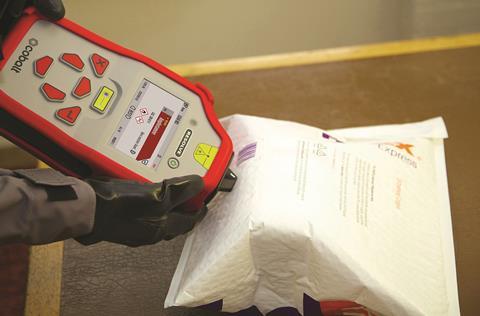
Agilent’s Resolve handheld Sors system doesn’t focus its beam onto a single spot like some other Raman systems do – it doesn’t even need to shine directly on it. Instead it shines a beam diagonally at the surface of the substance’s container, and measures the resulting scattered signal. Then it shines a second beam a short distance, or spatial offset, away, straight at the container and penetrates it even if it’s opaque. The beam causes Raman scattering in the material of interest in the same way as other spectrometers, some of which reaches the Resolve’s detector.
‘We compare the first measurement and the offset measurement using a complex algorithm, which can isolate the signal derived from the contents,’ Stokes explains. This subtraction reveals materials concealed inside containers made from coloured and opaque plastics, glass and fabric that could cause many different types of problems to other spectroscopy methods.
The algorithms underlying the method are a closely-guarded secret. However, they are made especially powerful to ensure that users don’t need to be highly-trained scientists – just to afford the roughly £45,000 a Resolve instrument costs. ‘It’s a detector, not a lab analytical instrument,’ Stokes stresses. ‘It’s got to make a call for the operator – is this a threat?’
Explosive potential
Identifying chemicals through barriers such as bottles and envelopes is a particular advantage, explains Rebecca Hopkins from the UK’s Defence Science and Technology Laboratory (DSTL) in Porton Down, UK. Thanks to this feature, Sors could enable rapid security screening at checkpoints, removing time-consuming and risky sampling steps, says Hopkins, who is group leader of chemical protection and detection at DSTL. ‘An example of this could be airport security checkpoints where liquids carried onto aircraft by passengers may be screened,’ she says. ‘The recent development of handheld Sors instruments could extend the potential of the technology to enable through-barrier detection in the field in both civilian and military scenarios where hazardous chemicals may be present.’
Handheld Sors is already being used to protect the health of people handling suspicious drugs, both legal and illegal. New drugs of abuse like the opioid carfentanil, a highly potent elephant tranquiliser, are increasingly being sold to humans. ‘If you breathe in a few particles you could be in trouble,’ Stokes says. ‘There have been many reports of police and prison officers injured.’ It’s therefore useful that the Resolve instrument can analyse them without opening their container, whether operators are in a lab or at a crime scene. Handheld Sors is similarly used in medicinal drug production, to test active pharmaceutical ingredients that can be toxic in the highly concentrated form manufacturers receive them in.
Handheld spectroscopy is still in its infancy
Today, we are all arguably safer thanks to handheld infrared and Raman spectroscopic detectors that enable rapid identification of unknown chemicals in the field. The instruments allow their users to make informed decisions about what to do next, such as donning personal protective equipment following the detection of a toxic chemical, explains Hopkins. And she looks forward to how ‘continued development of component technologies, such as laser sources and detectors, could lead to further miniaturisation and improved sensitivity’.
Handheld spectroscopy ‘is still in its relative infancy’, echoes Ellis. He compares it to mobile phone technology prior to the explosion of smartphones, and expects more big changes soon, especially thanks to cloud computing. Handheld spectroscopy today mostly has a single function as a highly mobile instrument with on-board chemical databases, Ellis observes. ‘We think this will change very rapidly over the next few years. It is just finding new areas where these can be applied and demonstrate their capabilities and potential.’
Article updated 6 February 2018 to clarify and correct the spectral range of the FirstGuard and Bravo instruments
References
1 D Ellis et al, Anal. Methods, 2015, 7, 9401 (DOI: 10.1039/c5ay02048d)
2 B Wilson et al, Am. J. Trop. Med. Hyg., 2017, 96, 1117 (DOI: 10.4269/ajtmh.16-0904)
3 D Ellis et al, Sci. Rep., 2017, 7, 12082 (DOI: 10.1038/s41598-017-12263-0)
Quotes from Rebecca Hopkins are © Crown copyright (2017), DSTL. This material is licensed under the terms of the Open Government Licence except where otherwise stated. To view this licence, visit the National Archives website or write to the Information Policy Team, The National Archives, Kew, London TW9 4DU, or email: psi@nationalarchives.gsi.gov.uk





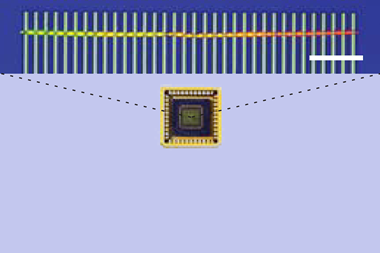
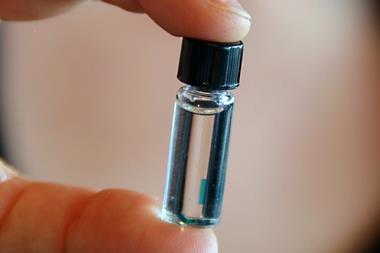










No comments yet